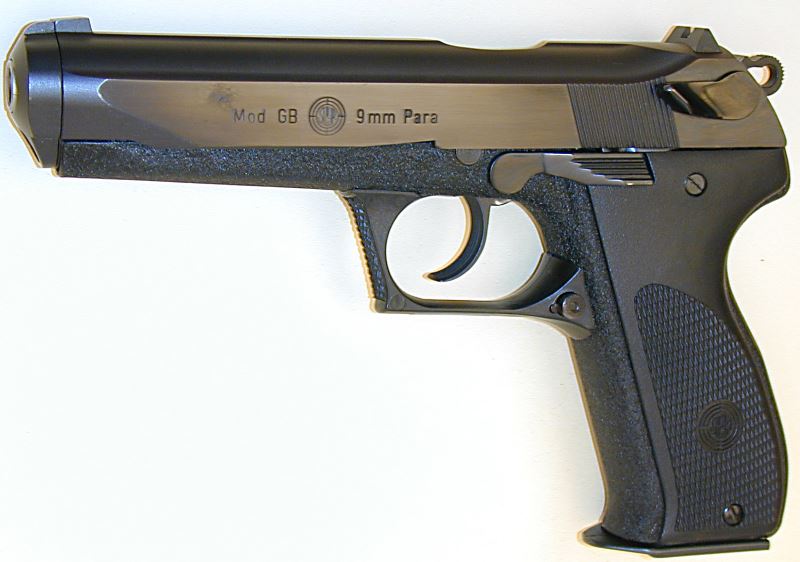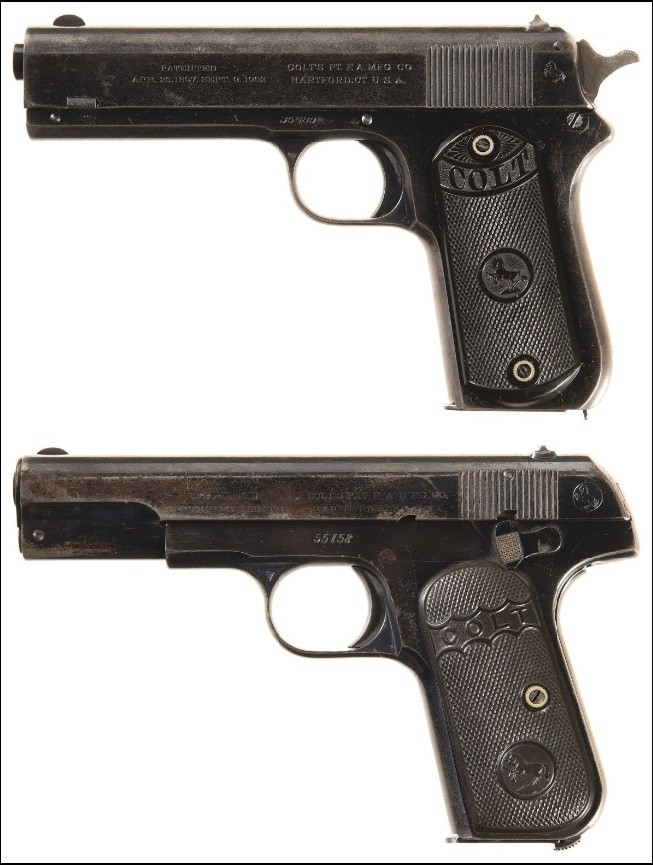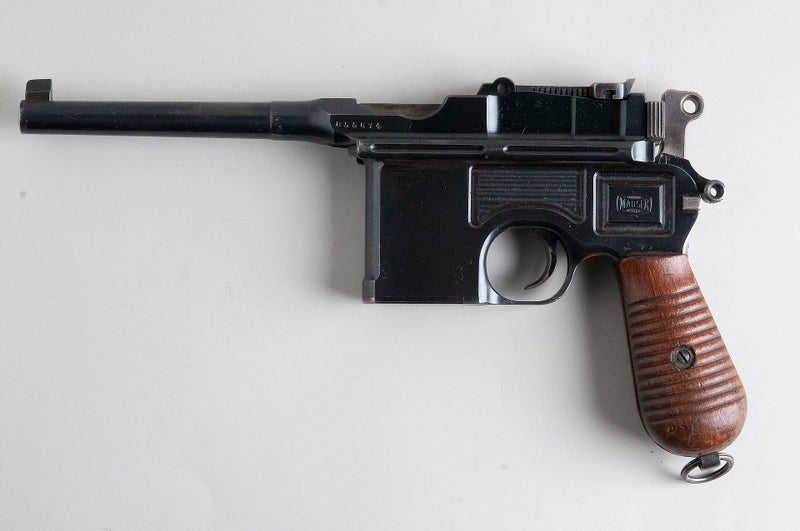Go  | New  | Find  | Notify  | Tools  | Reply  |  |
Fighting the good fight |
The P250, the predecessor to the P320, had the same modular FCU design later utilized by the P320. It came out ~7 years before the P320 (2007 vs. 2014). So of the two, the P250 was the innovative one. It just wasn't as commercially successful, due to the long DAO hammer-fired system, compared to the P320's striker-fired system. (I also don't think the P250 was really marketed as well as the P320... Even from its introduction, the P250 seemed like kind of the "redheaded stepchild" of the Sig lineup.) And while not as quick to remove as the P250/P320 FCUs, there were a few other handguns with removable serialized FCUs introduced prior to the P320 as well, including the Beretta Nano (introduced 2011) and Beretta Pico (introduced 2013). These are similar to the P365's chassis, in that pins have to be driven out to remove the FCU. | |||
|
| Frequent Denizen of the Twilight Zone  |
At $5000 and not really "out there" yet, will it last? | |||
|
| Member |
I just thought I would add a side point on the Mauser broom handle, the NYPD had a gun buyback program and only around 40 firearms were turned in however by looking at the photo there was some type of C 96 and a Mauser HSC, if I am not mistaken. ----------------------------------------------------------------------------------------------------------------------------------------------------------------------------------------- Democracy is 2 Wolves & a Lamb debating the lunch menu. Liberty is a well armed Lamb! | |||
|
Fighting the good fight |
Yeah, these gun buybacks occasionally get some old historical firearms turned in by ignorant owners. I recall one buyback from about a decade ago in CT where someone tried to turn in a WW2-bringback StG-44, which is a rare find worth about $30k, in exchange for a $200 gift card. Luckily, one of the officers involved was a gun collector who recognized what it was, and the department instead made arrangements for the owner to transfer it to a museum instead, where it's now part of a historical collection instead of being destroyed.  Shortly thereafter, the same thing occurred in Los Angeles, but LAPD declined to rescue that one and allowed it to be sent off for destruction.  | |||
|
| Member |
I second the BHP. It was a game changer. | |||
|
| Gracie Allen is my personal savior! |
Ahem. The Steyr M (and C and S) Series predated all of those pistols. | |||
|
Fighting the good fight |
But unlike those other pistols mentioned, while the Steyrs have a removable fire control group, the polymer frame itself was still the serialized firearm portion, just like a Glock or other traditional polymer handgun. So it wasn't truly modular like the P250 et al, since you couldn't swap that trigger group to a different grip without buying a whole separate "firearm" (serialized frame)... it basically just meant it was slightly easier to remove the trigger group as a whole from the gun for deep cleaning. Ahem. It wasn't until 2019 that Steyr released the A2 MF series as an actual modular gun with the removable FCU as the serialized portion. So while they had all the components necessary to have been the first out of the gate for the "handgun with serialized FCU and modular grips/slides" concept, for whatever reason they chose not to pursue it until several years post-P320. (It's likely that they didn't think there was much demand for it, and were stuck playing catch-up once the P320 proved that assumption wrong.)  | |||
|
| Gracie Allen is my personal savior! |
Ah, well, if you count keeping up with legal technicalities as "innovative", then I guess the actual technical innovation, you know, the removable chassis, just doesn't matter. | |||
|
Fighting the good fight |
Steyr came out with the FCU concept first. Sig innovated further with it, by utilizing the concept of a serialized FCU to allow for truly modular handguns with interchangeable slides and grips, which the Steyrs lacked. Both innovative, in their own way. But if you're talking about serialized FCUs and modularity (as I was), it starts with Sig, not Steyr. | |||
|
| Ignored facts still exist |
1911 | |||
|
Fighting the good fight |
I dunno... I find it hard to label the 1911 itself as strictly "innovative", considering it's simply the culmination of a long stretch of previous models (from the Colt Model 1900 to 1902 to 1903 to 1905 to 1907 to 1909 to 1910 to finally 1911) dating back over a decade, over the course of whose development all of the design features of the eventual military-adopted Model 1911 were gradually introduced and tweaked. Certainly more refined and successful than its predecessors, but not necessarily innovative. Basically everything included in the M1911 was already in place by the M1910, and the innovations all came with Browning's work on earlier models in the lineage (with the 1900 and 1909 being the major innovation milestones, IMO). | |||
|
Member |
The serialized FCU is only an issue in the US, btw. In some parts of the world, the barrel can be the restricted part (not the “lower”, as is the case in the US). So serializing the FCU is a US innovation, but the actual work of making a modular FCU is more important. Heck, Steyr’s new production runs of MF A2 is again going to have bare FCUs (no serial) due to ATF concerns/import related BS. | |||
|
| Member |
I have to disagree with this. Yes, the 1911 was an evolutionary design. Basically all those previous versions were design experiments and it took John Browning 10 years to refine his original concept to it's final perfection. However, it was the first Tilting Barrel Semi Automatic pistol to be adopted for Military use. Take a look at the semi auto handgun market today and only 2 basic designs are in common use. One is a tilting barrel semi the other a straight blowback. The reason for that is that these designs are cost/performance winners. I've stopped counting. | |||
|
| Member |
In the Colt/Browning family, I see two generations. The original 1900-1907 "parallel ruler" guns then a major redesign to the single link tilting barrel action in 1909. It was only five years from the Army announcing a need for a new .45, preferably an automatic, until the adoption of the 1911. I have often said that today's Army could not approve a new toothbrush in five years. | |||
|
Fighting the good fight |
The swinging-link tilting barrel was already in place with the 1909 (as Jim Watson also pointed out). Thus making the 1909 the revolutionary/innovative one in that regard, not the 1911. The 1900 introduced the overall concept and layout. The 1909 introduced further major features like the swinging link barrel and barrel bushing. Thus my earlier statement:
Additionally, while these predecessor Colt models didn't reach the widespread adopton and production as the 1911, they were not all just "design experiments" or workshop prototypes. The earlier models (1900-1905) were all commercially produced and sold in the thousands, with some being purchased for military use. And some of the later models (1907 and 1909) went into production in a smaller quantity (a few dozen to a few hundred apiece) for military field trials. Only the 1910 was closest to strictly a "prototype" or "design experiment", with only 8 total being produced for military testing. And that's mainly because the only real changes in the 1910 over the 1909 were the addition of the requested thumb safety and a slight tweak to the grip angle. So once the military was satisfied with those small changes on the 1910, with the prior models having already proven themselves in testing and field trials, it went straight to being adopted as the 1911 without the need for any further production and trials of the 1910. | |||
|
| Member |
Handgun as multi-tool: HK P7. Need a bullet-spitter/hand warmer/squeeze stress-reliever/grip strengthener? Then the P7 is your only choice. I think it was a Steyr that was actually the first gas delayed blowback pistol, but it was the P7 and its offshoots that serves as the "wet dream" design of the type. Whether it's 'most' innovative...well, it's out of production. 1911s and Glocks are not. Both have their fervent followers...and copycats. Only the Walther CCP is carrying the torch for the gas blowback pistol concept.
That design has a lot going for it but its concepts and innovations should be more centered on mass-market adoption and on the less luxury toy/competition niche before it can truly be considered "serious". Get a sizable military and/or police contract, then there's a legit argument. Or if suddenly it becomes the "IT" comp handgun of choice because its users are regularly mopping up their competition...again that would be reasonable justification for such a claim of 'most innovative'. But as of right now it's yet to have proven itself in the marketplace. -MG | |||
|
Fighting the good fight |
That'd be the Steyr GB, an infamous "also ran". After losing out in the early 1980s to the Glock in its home-country Austrian military trials, and to the Beretta 92 in the US military trials, it basically faded into obscurity.  | |||
|
fugitive from reality |
I'll third this. The BHP used both the double column magazine and the Browning tilting barrel design. _____________________________ 'I'm pretty fly for a white guy'. | |||
|
| The Ice Cream Man |
I think the Colt 1908 pocket auto might count. The 380 one was the first “Mighty Mouse” carry gun, TMK. | |||
|
Fighting the good fight |
What about the earlier Colt 1903 Pocket Hammer? It was a contemporary of the 1903 Pocket Hammerless in .32 ACP, predating the .380 Pocket Hammerless by 5 years. And it's similar in size to the 1903/1908 Pocket Hammerless models. But it was chambered in .38 ACP, which is a bit stouter than .380, and a lot stouter than .32. (Closer to 9mm Para than .380, .38 ACP would go on to be souped up to become .38 Super.) Colt 1903 Pocket Hammer above a Colt 1903 Pocket Hammerless:  | |||
|
| Powered by Social Strata | Page 1 2 3 |
| Please Wait. Your request is being processed... |
|
© SIGforum 2025
